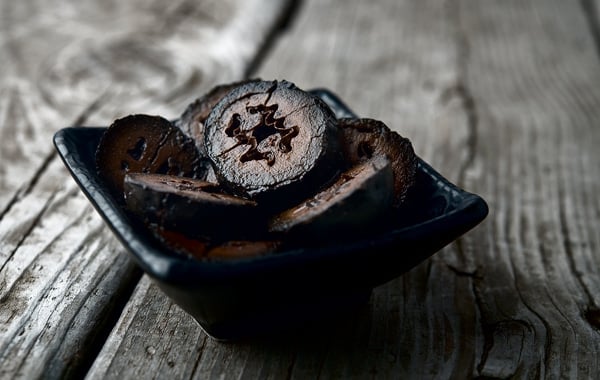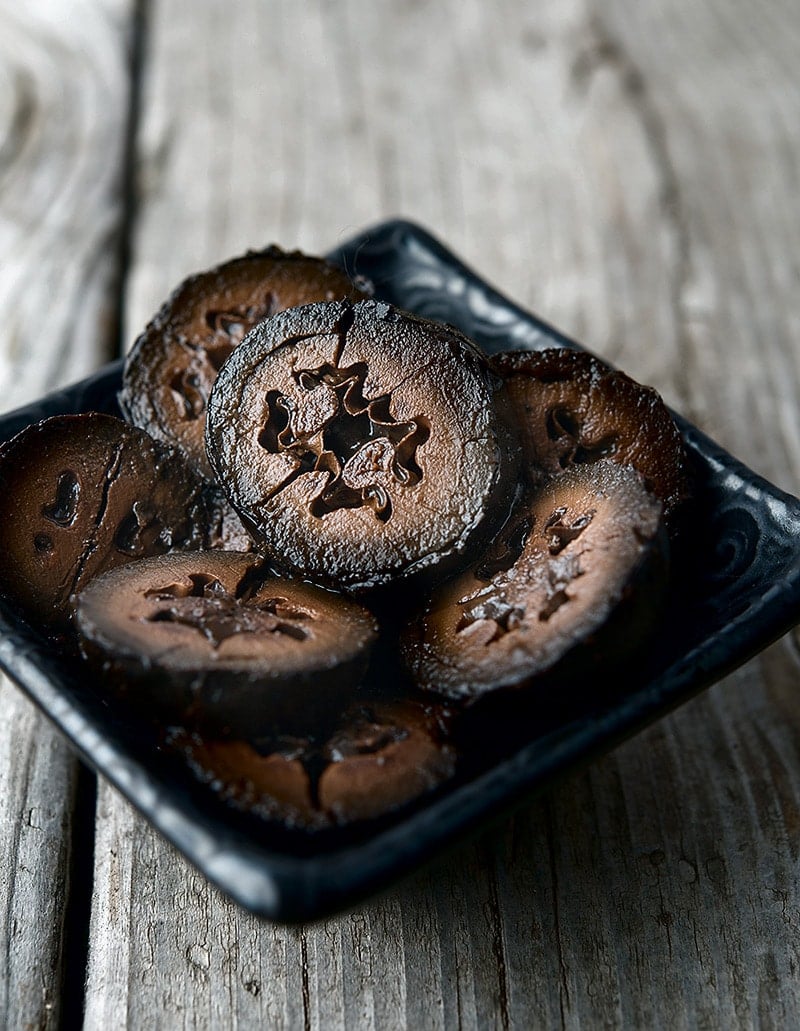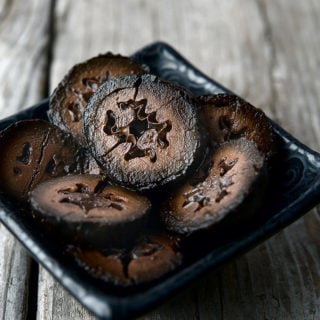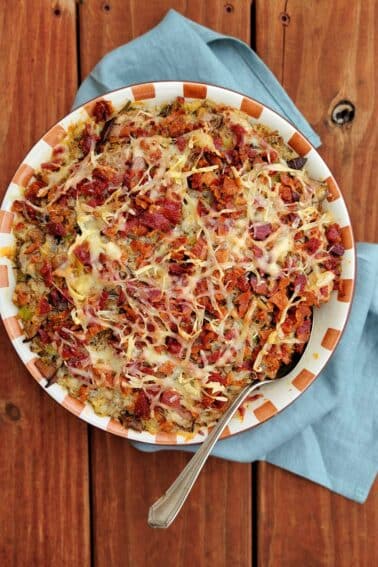As an Amazon Associate I earn from qualifying purchases.

There may be a few foods that are more English than pickled walnuts, but with the possible exception of fish and chips, I can’t think of one. Chances are, however, you’ve never heard of them. I hadn’t, until several years ago when I ordered the meat-and-cheese plate at a local Irish place called deVere’s.
On this place was a black disk. I asked the waitress what on earth it was, and she smiled; she’d had this question before: “It’s a pickled walnut. It’s good with the cheddar.”
I followed her advice and stabbed the disk with my fork, adding a bit of cheddar cheese and a bit of cold roast beef to round things out. Wow. It was a bit like eating solid steak sauce, with a little floral aroma and a zephyr of bitterness that just barely let you notice it.
I ate another disk all by itself: Fairly soft, puckery and strangely floral. And yes, there was definitely a Worcestershire-Heinz 57-A1-thing going on here. How had I never had these before?
Turns out that very, very few people outside of Britain eat them. This should change, which is why I am presenting you with this recipe. And the reason I am posting this now is because you need to get out and get your walnuts now. That’s right, you need green, unripe walnuts to make pickles. And yes, you use the whole thing, hull and all.

I got mine a few weeks ago, after an unsuccessful fishing trip with my friend Joe. We were in the Delta and as we were driving out, I noticed a NorCal black walnut (Juglans hindsii) absolutely laden down with nuts. “Pull over!” Joe, used to this by now, did. I gathered about 150 nuts in less than 15 minutes. It was a bonanza.
I knew I was in business right when I got to the tree, but just to be sure I pulled out my pocketknife and sliced an unripe nut in half. You need to do this, either with a knife or a stout needle or a long nail, because you have to catch the unripe walnuts before the shell forms. Once that shell forms inside the walnut’s hull, you’re too late; the traditional harvest date in England is late June.
The process for pickled walnuts is not hard at all, but it takes more than a week. You need to brine the green walnuts for a good long time before they will be ready to pickle properly. The brine time helps with preservation and removes some of the bitterness in the unripe walnuts. Once brine pickled, they are pretty durable.
Do you need to sun-blacken the walnuts? No, but doing so gives you a nice, uniform look to them. Otherwise they will be olive green in some places, blotchy black in others.

Once you have your pickled walnuts, what do you do with them? Look to the English. Traditionally they are part of a ploughman’s lunch, with other pickles, cheese and cold meats. But I see them a lot tossed into beef or lamb stews (pot pies and pasties, too!) in wintertime, and in summertime I’ve seen them served in cool salads alongside tomatoes, and accompanying shellfish such as scallops or shrimp.
Pickled Walnuts
Ingredients
- About 50 to 60 green, unripe walnuts
- 1/2 cup kosher salt
- 1/2 gallon water
- 2 quarts cider or malt vinegar
- 1 tablespoon cracked black pepper
- 1 tablespoon cracked allspice berries
- 1 ounce ginger, about 1 1/2-inch pieces, smashed
- 1 cup brown sugar
Instructions
- Dissolve the salt in the water to make a brine. Put on some rubber gloves if you have them, because walnut juice will stain your hands for weeks -- and it won't come off. Trust me on this one. Properly gloved, stab each walnut with a fork in several places; this helps the brine penetrate. Submerge the walnuts in the brine and let them ferment for 8 days at room temperature.
- Remove the walnuts and put them on a baking sheet and leave them outside in the sun for a day, until they turn uniformly black. You can do this step without gloves if you want.
- Pack the walnuts into quart jars. Bring the remaining ingredients to a boil and pour over the walnuts. Leave very little headspace in the jars. Seal and keep in a cool place, either the fridge or a basement -- you just want them to rest below 70°F -- for at least a month before you eat them. Kept this way they will last a year.
Notes
Nutrition
Nutrition information is automatically calculated, so should only be used as an approximation.






Thanks
Hi, i’m in New Zealand and at the point of removing my walnuts to blacken but its raining and set to do do for days! What shall i do? n
Heather: Put them in a garage. Air is more important than sun for this process.
Hi all,
Interested to read all the posts.
Chris is my walnut pickling partner (son) and I am a little ahead of him in that, while he is on holiday, I have finished the brining process and have now been drying the walnuts in the shed for 2 days and they have blackened evenly.
I note they are softening a little but still yield a little moisture when squeezed. I plan to leave them a couple more days before the final pickling. I’m getting a tiny bit excited and am loving comparing notes with Chris on the process.
Hello, I’m in Concord, CA, and 50 years ago I wouldn’t have had a problem finding perfect fruit for these, but I just heard of it the other day, and there aren’t any more walnut trees that I know of around here anymore. I may just have to dream about trying them someday, but in the event someday actually comes, do I really need the sugar? I had to stop eating it awhile back, and I don’t ever remember liking sweet pickles anyway. Thanks, you have a wonderful site here. Silva
Silva: There are tons and tons and tons of walnuts from the Delta throughout the Valley. So you’ll just need to drive. I’d look around the Delta parks. As for sugar, I wouldn’t eat these without it, but it’s up to you.
G’day Hank,
I’m writing from Tasmania, Australia.
Luckily we are right in the season for this and I have 8.5 kgs on the go, been in brine for about 5 days!!!
Next week (in 6 days), we will embark on a two week SUMMER holiday and I fear my timing was a bit dodgy. However, your recipe is the first one I have come across with a brine treatment of less than 14 days, which is promising for me.
Do you think the walnuts will be ok over this time:
a) kept in a fresh batch of brine at room temp
b) kept in a fresh batch of brine in the fridge
c) the whole lot left to pickle in a large container?
I am guessing putting into a large plastic drum to pickle at room temp is best solution, then jar up later??? Any problems with this?
What do you think?
Cheers mate.
Chris.
Chris: I think you should be fine at room temperature — if that temp is less than 23 degrees Celsius or so. If it’s going to be hotter, put them someplace cooler.
For those down under my optimal pick date is 30 November
Pick too late and you eat wood – pleasantly flavoured but still wood.
Pick too early and they won’t hold together to slice but still make good tapanade to have with crumbly feta or similar
Hello, new to pickled walnuts but my Englishman neighbor talks about pickling walnuts with his father. I thought I would give it a shot next year. Your recipe sounds straight forward…..my question is when serving you just take them out of jar and slice…you eat the outer layer and all not just walnut inside? Thanks for great information. I am hoping to find some English Bleu Cheese to go with the pickles, that is how his mom served it when he was a child.
Tracy: Yep. I serve the whole thing. Some people pick off the think outer layer, though.
I feared that, Hank.
I picked the rest of the walnuts today so will probably have to eat them at Christmas as nuts.
I shall put “Pick Walnuts” in my 2016 diary for mid June. Tree will be a bit bigger by then; any ideas how to get up in the tree to pick them other than a ladder or climbing the tree? But I noticed today that the branches seem to break off easily.
I will buy pickled walnuts as presents for my family for Christmas!
Tony
Hi, here in Sussex, England, regularly every year the grey squirrels get to the nuts before I do and strip the tree bare! So today I went and picked all the green walnuts reachable and will take a ladder tomorrow to pick the rest. However, this is mid September and could mean that the shell has hardened; have yet to prick them. Is ther3e any way I can still pickle them if they have a shell hardening inside? eg, can the hull outside be pickled? You see I have the problem of no nuts because of the squirrels or waiting again til next year, June, when I tend to forget when the weather is nice for sailing! S’pose I could just go out and buy a jar!
Tony: Sorry, you are out of luck. You need to make these in early June.
Hi. I’m making these to sell at my local Farmers Market and have loads of interest in them. I’ve finished the brining and currently have them drying out. How dry should they be before they are ready to be put into jars? They are on Day 2 of drying. Want to get it right as i have almost 15kg to jar up! Thanks
Ray: Huh. I’ve never heard of anyone making pickled walnuts in August. Have you tried one yet?
Must you pick the walnuts off the tree or can you use fallen green nuts? On the tree will be the ones that ripen, the falls are discarded by the tree. Which do you use? Next season…
Barb: I pick off the tree.
Thanks so much for the information. Here in Minnesota, I’m almost to day 8 of fermenting in the brine and have a few questions for the next step. Any reason I couldn’t pack into pint or half gallon jars (I only have 12 quart jars on hand and estimate I would need more like 16). Also, being new to pickling, do the jars need to seal airtight or can I use spent (pre used) lids for this? Should I need to water bath or just wet new lids with a boiling fill? Lastly, our cold cellar will stay well below 70 but does tend to be a bit humid this time of year. Any particular concerns there with respect to pickling? Thanks in advance for any further pointers.
Nathan: Yep, you can use smaller jars and yes, just use pre used lids. If you keep everything in the basement, you should be fine.
Hank,
My dad made some recently and they are excellent! Ate them as part of an Antipasto dish and were great on the cheese, cracker, meat medley. Also had them a top a grilled NY steak with melted blue cheese crumbles and they went really well together. Thanks for the old world recipe.
Guy
I am making these now after years of wanting to try them – I finally got the timing right with the trees.
I set them outside in the sun on a dark cookie sheet, and it’s an extremely hot summer here. I went back to check them and the sheet was very hot, and some of the walnuts were cooked and turned mush when I packed them into jars!
I wonder if I had just left them on the counter for the day, or even in the shade, if they would have blackened up fine. As it is, I think the final texture will be soft, but the flavor good. Even the brine-only walnuts were pretty tasty. Remind me of salt cured black olives.
Kate: oh no! Yes, they need sun in England, but not in hot places. I just put them out on a sunny counter indoors. Bummer. You can put the mushy ones in a food processor and make a sort of tapenade out of them.
Hi Hank, you mentioned mold is fine, I just wondered to what degree… after 6 days in brine, the whole surface of my brine was covered in a bounty of white, brown and blueish grey molds. 😛 I’d love to send you a picture…
I think what happened is the water level dropped a smidge, so all the tops of the walnuts sticking out of the brine grew mold. I scraped the mold off as best I could per your advice, but I know there are still lots of fragments in there.
My question is: does the rest of the pickling process (vinegar etc) kill off any mold that would be harmful? Still a usable batch, do you think?
Many thanks for all your recipes and responses.
Lincoln: Oh, that’s not ideal. I’d discard the walnuts that broke the surface of the water, and add more pure brine of the same strength (1/4 cup kosher salt to 1 quart water) Yes, the pickling process will kill most of the molds. You should do your best to skim them off, too.
Hi Hank, thanks for your experiences – love the photos and your writing. I have young, tender, black walnuts sitting in brine now, but as I was eager to see what it tastes like, I went to the local British store (I’m in Ontario, Canada) and picked up an “authentic” jar of “Opies Pickled Walnuts in Malt Vinegar.” Just have the right stuff on hand, I sliced some old cheese up and then went on to the walnuts – excitement! What a let-down. Opies pickled walnuts are mushy, slimey and very sweet-sour. I couldn’t even pick up a trace of that julone-laced lemony-walnut scent that is so telling of black walnuts. Chances are, they were regular walnuts. But the texture was off-putting. Were your crisp, or at least somewhat firm? …I hope?
Jennie: Pickled walnuts are never firm, alas. They always get soft.
I’ve saved this recipe from when you posted it last year. My brine is coming to a boil this very minute. Subbed Cambodian red pepper for the black and juniper berries for the allspice. Can’t wait for the end of July…
I’m trying this now after being to late last year. I started the soak but after 4 days, mold developed on the top if the water, what am I doing wrong? Also thought about trying with butternut but I am curious about the sticky outer hull?
Shannon: Mold is fine. Just skim it off. Never tried it with a butternut, though, as they don’t grow in California.
I’m a Canadian living in Cyprus. Here they only know to make the sweet version of black walnut preserves, a fantastic ‘spoon sweet’ traditionally served to visitors. But I remembered having the vinegary version on a cruise ship as a teenager and last year tried to make some, with reasonable success but not very attractive in taste like you describe as I only stored them in vinegar-salt solution. Reading your site I have now learned to blacken the walnuts in the sun to make them more uniform and will also add the spices etc.
Here in Cyprus they prepare the walnuts by peeling a thin layer of skin off then soak the fruit in water every day changing the water daily for 8 days. This removes the bitterness. That is what I did last year, but now I will try the method you stated of using the whole fruits, hull and all. The time to pick the green walnuts in Cyprus is at the beginning of June. There was actually a walnut festival last week-end in Lefke, where the walnut trees grow.
I’ve been waiting since trying the walnuts a year ago. We went down to the bike trail this afternoon and picked enough for pickling and Nocino. Thanks for the recipe.